Hyperlocal marketing is a little different from local marketing.
Local marketing means targeting a city or state.
Hyperlocal means being more specific, targeting people in their homes, at work, at local stores that are a few blocks or streets away.
Have you ever wanted to find a local store or office when you were out?
If your answer is yes, then you’ve conducted a hyperlocal search.
Customers want to buy from businesses near them. According to a survey, 82% of smartphone shoppers conduct “near me” searches.
Google also revealed that there was a 500% increase in growth in “near me” mobile searches that contain phrases like “can I buy” or “to buy” between 2015 and 2017.

Start doing hyperlocal marketing if you want to grow your local business. In this article, you’ll learn 13 ways to gain new customers with hyperlocal marketing.
1. Optimize your Google My Business listing
Google My Business is a free tool that allows businesses and organizations to manage their online presence across Google.
For example, if you search for “elder law Maryland attorney” on Google, you’ll see a few firms from Maps on the first page of search results.
In the screenshot below, Elville and Associates, P.C. is the first result.
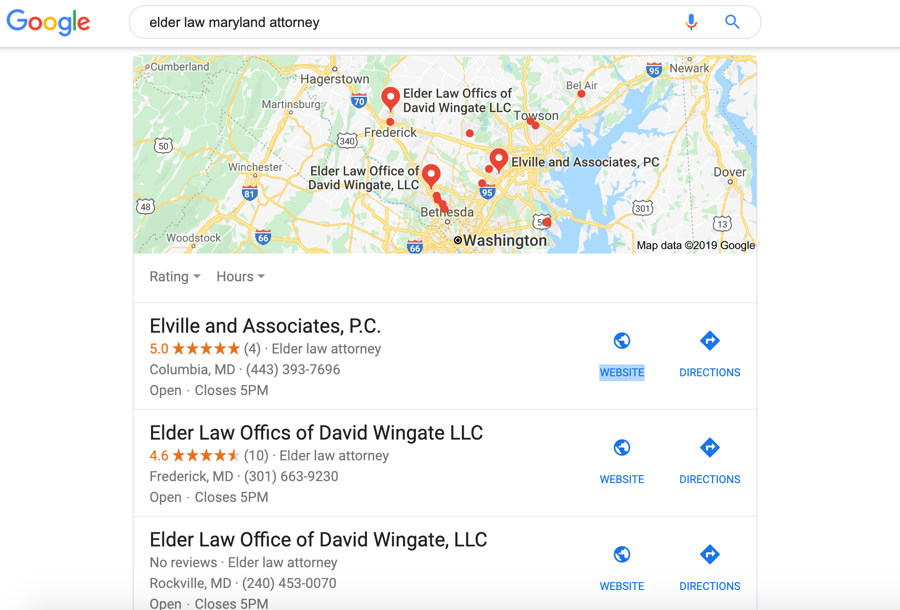
You can see when the firm closes, the link to its website and another link to view directions to get there.
Below is another screenshot of how the business appears on Google Maps.
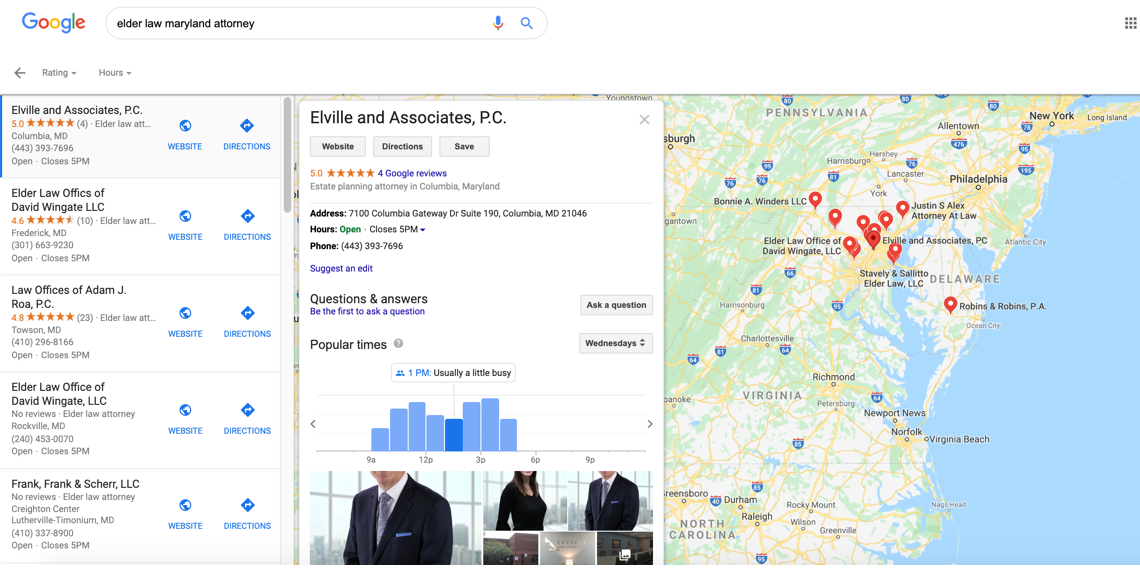
Clicking on the business allows you to see more information. You can view the company’s address, busiest times of the day, photos, links to their social media accounts, and reviews.
For searchers to see this kind of organized information about your company on Google, you need to optimize your Google My Business page. Fill out all the information Google asks.
Even if you don’t have a store or office in a location, Google still allows you to list your company as a “service area business.”
Using Google My Business is easy. If you haven’t added your business yet, visit this link to do that.
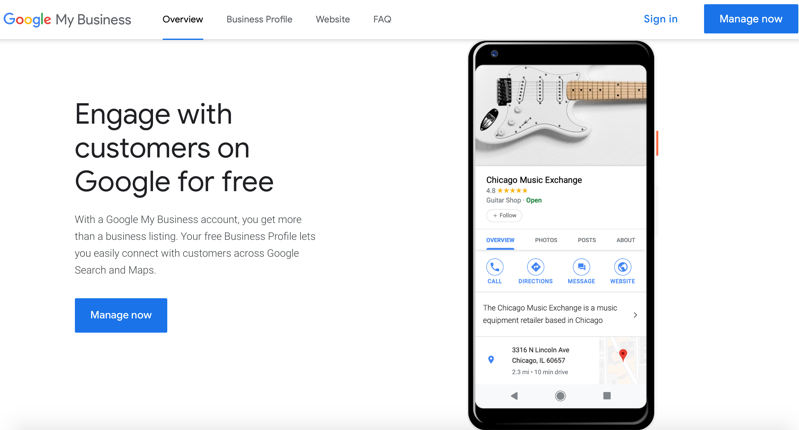
2. Create content that targets local keywords
Instead of creating content that competes globally or nationwide, why not produce content that appeals to people in your locality?
For example, if you own an SEO company in Kansas City, you should include keywords of the city in your content.
Write an article like “The Best SEO firms in Kansas City.” You would have a better chance of ranking for that keyword when people are looking for the best SEO company in your city than when targeting the whole United States or the world.
Searchers in Kansas City would find your content helpful and are more likely to contact you than a random individual in another continent or state.
But if your company serves customers from everywhere in the country, then it’s okay if you don’t include local keywords in your content.
For example, the car hauling automation startup, Super Dispatch doesn’t need to use local keywords in their articles.
Their blog posts cater to everyone within the country who needs their service. The blog post in the below screenshot is a perfect example.
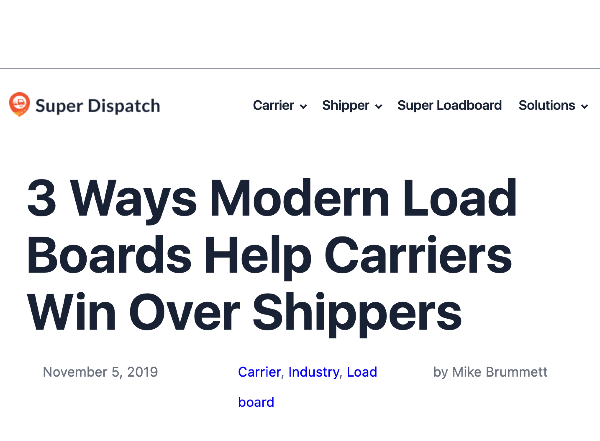
Still, I believe that any business would massively benefit from targeting local keywords in their content.
It’s easy to unearth some nice local keywords. All you need to do is find some broad keywords. Then add the location you want to target.
For example, the keyword “the best SEO agency” becomes “the best SEO agency in Kansas.” And that’s it!
3. Add your contact information to your website and make it visible
People who are ready to buy your products and services want to contact you. But if they can’t find your contact information, they would leave.
One of the things people want to see on your site is your phone number and address. If you can’t add a contact form to your home page, there should be a clear link that leads people to your contact page.
If your business has multiple locations, add all the locations, including their contact information to your footer. But if you only have one location, the header is the best place to put your phone number.
For example, On Your 6 Designs is a family-owned and operated company that sells handmade Kydex holsters. The company is based in San Antonio. They ensure that their contact information is visible in the header of the site.
In case you can’t put the full address of your business in the header, ensure that it’s in the footer. Visitors who have scrolled to the bottom of your site would have the chance to see your contact information again.
4. Create a consistent experience for both online and offline
According to a study, 97% of consumers learn more about a local company online than anywhere else.
People search for your local business online before deciding to visit it later offline. Because of this reason, the experience of your brand should be consistent everywhere.
Consumers shouldn’t feel confused before and when they visit your location.
I once visited a business location and was surprised to see that the logo I saw on the website is different from the one at the address. I thought I was in the wrong place.
Your logo should be the same across all marketing channels. The logo people see on Facebook, Twitter, and Instagram shouldn’t be different from the one on your website.
And the logo you have online should be the exact logo offline.
Consumers love consistency when dealing with local businesses.
Another way to create consistency is by using the same tone for your copy, both offline and online.
For example, if you use positive words on your website and social media, you should continue that offline.
What you’re doing online shouldn’t be different from what customers get offline. If you’re struggling with consistency, I recommend you hire a brand expert.
5. Create authentic, great local content
Local content would help you get the attention of customers. But your content needs to be authentic and great.
Don’t publish mediocre content and expect people to visit your business location.
Big brands do have the money and team to dominate local search results with high-quality content. They often don’t invest in local-specific content because their goal is to dominate the entire country and world with their content.
Your local content is like David’s slingshot to Goliath’s plate of armor.
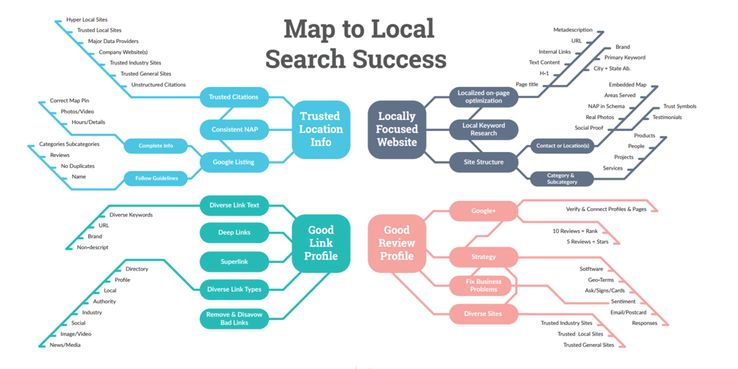
To compete with the big brands, you don’t have to write often. You only have to write quality local content that would rank for years to come.
6. Get online reviews
According to a study, 92% of consumers rely on reviews when making a local buying decision.
Reviews are one of the most important ranking factors on local search directories like Google and Yelp.
According to a Local Consumer Review Survey conducted by BrightLocal, about 50% of consumers interviewed in 2018 said they would visit the website of a business after reading a positive review.
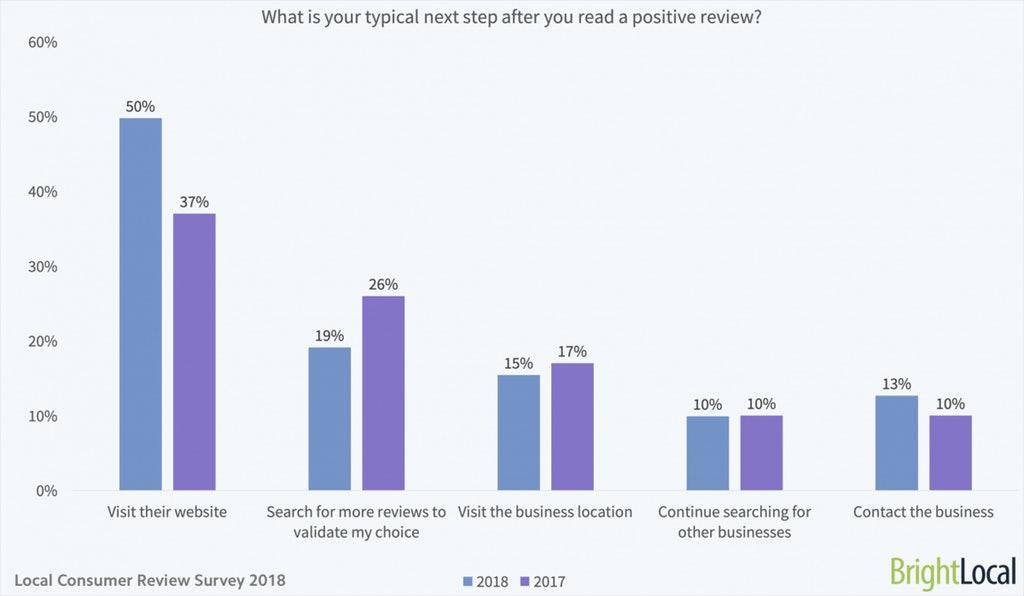
Ask your local customers to drop a positive review of your business on platforms like Google, Yelp, Bing Local, and Facebook.
The more positive reviews you have, the better it is for your local business.
And please don’t ask all customers for reviews at once. That would be unnatural. A local business owner once told me that they would ask all their 500+ clients to drop positive reviews on their business on Google. I asked them not to do that.
Maverick Texas Brasserie, a French restaurant in San Antonio has received over 500 reviews on Google and enjoys 4.5 average stars from customers.
Gain your reviews gradually. Getting five positive reviews per week won’t hurt.
7. Use location-based advertising
What is location-based advertising?
Top platforms like Google, Facebook, and Bing know where your customers are. Consumers share their location data through the mobile phones they carry around.
For example, Google could tell the difference between someone that lives in a particular location and the person traveling.
With the huge location data these companies have, they allow you to target consumers who are close to your store.
For example, if you want to attract travelers to your store, you target them with ads. You can also target someone who’s around your competitors’ store or office.
Location-based advertising is a form of hyperlocal marketing you should start using today if you want to compete.
Location-based advertising could even be more effective if you do other things outlined on this page.
For example, if you have an active Google My Business listing, and you’re creating great local content, some locals would have been already familiar with your business. So, getting them to visit your store or office when they see it in ads won’t be difficult at all.
8. Add local schema markup to your website
Schema markup can help search engines understand more about your business and what it does. The more information you give search engines, the better they would present your website to searchers.
If searchers see a nice listing that tells them a lot before they even visit your website, it increases your chances of converting them into customers.
For example, here’s a schema markup for an organization.

As you can see, there are details like the company’s customer’s support phone numbers, headquarters location, subsidiaries, and more. And there’s also an option to search Oracle directly on Google.
For example, Earth Class Mail receives your paper documents through a virtual address and scan it for you to view online. They use schema markup.
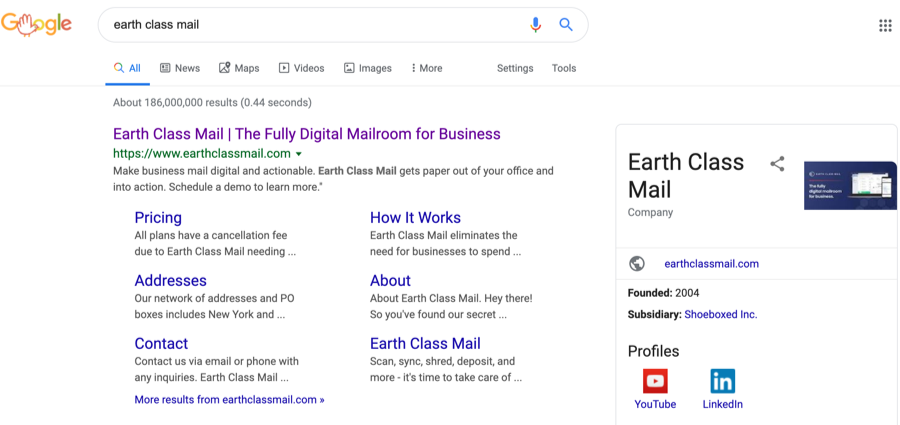
You could see the year Earth Class Mail was founded on Google.
Using schema markup would help your local business stand out in search results pages.
9. Make your website mobile-friendly
Google revealed that 61% of its users are unlikely to return to a mobile site they had trouble accessing, and 40% would visit a competitor’s site instead.
A mobile-friendly site is easy to use. A ten-year-old should be able to navigate the site without issues.
More and more people start their purchase on their mobile devices. For example, Target saw that 98% of its guests shopping digitally, and 75% were starting on mobile.
Before consumers visit your store, they would have checked out your site on their mobile devices. That’s why you need to make your site so mobile-friendly so that people would be able to find the information they’re looking for very quickly.
10. Team up with non-competing local businesses
There are lots of businesses in your area that are not competitors.
What if you partner together to send customers to each other? That would be a win-win for both businesses.
While it’s true that you can’t partner with every business out there, some businesses would benefit from partnering with you, and vice versa.
Two heads are better than one. In some cases, two companies are better than one, especially when you combine resources and share expertise.
The partnership doesn’t have to be a big deal. It could be sharing marketing efforts, offering referrals with or without commission, or sharing information and advice.
11. Partner with local charities
Charitable giving helps you humanize your brand, build positive change in the community, and cultivate compassion with customers and the public. Some local companies are now supporting important causes by developing charitable partnerships.
Partnering with local charities could create more awareness for your business, but that shouldn’t be your primary aim.
If you don’t want your company to have a strong social or environmental commitment, don’t partner with local charities. It wouldn’t be authentic.
But if you believe that supporting a social or environmental cause is the right thing to do, then you should. It would have a huge positive impact on your business.
For example, Boston-based advertising agency Connelly Partners asks their employees to teach high school students the basics of marketing. They invite more students of color into the marketing world by employing them and paying off their students’ loans.
Godfrey Hotel Boston encourages its employees to volunteer at a shelter or food bank. The hotel pays employees for the time they’re volunteering.
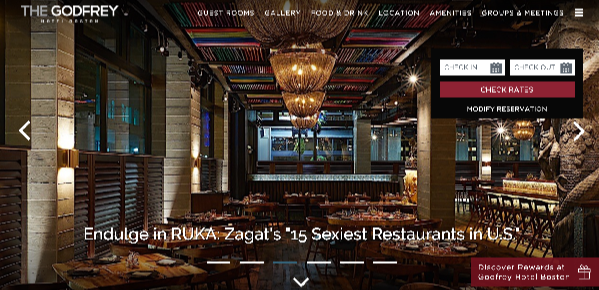
12. Provide an exquisite in-store or office experience
By providing customers with an enjoyable shopping experience, you’ll get to turn them into repeat customers.
Consumers would return to a store where they were welcomed and treasured the last time.
As a local business, you need to value your present customers. Keeping them happy puts your business in a better position to retain future customers.
And one of the best ways to keep current customers happy is to “WOW” them.
If you have a store where customers visit to buy, you need to give them the best experience while they’re there. And if you have an office where clients visit, you need to treat them well while delivering the best service.
Offer customers an extraordinary, unique experience they won’t get elsewhere.
For example, Morning Lavender is a chick café in Tuskin, CA. They sell delicious coffee and tea drinks. The business has flowers on its walls to encourage customers to take photos while they’re in-store.
Customers put those pictures on social media, and that generates more awareness for Morning Lavender.
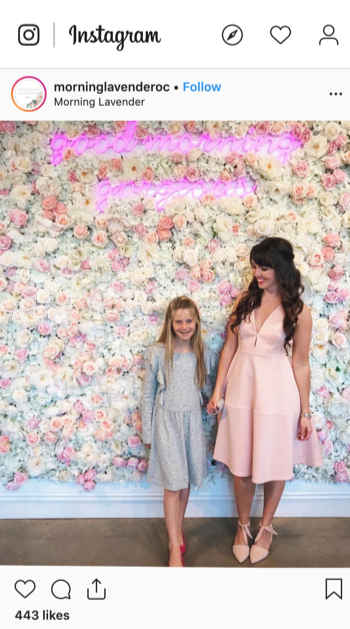
The point is that customers are more likely to return. And maybe with their friends next time.
Start with your employees. To make your customers feel great at your business location, employees have to be happy. They can’t deliver when they’re not happy.
If customers normally bring kids to your store or office, it means you also have to cater to those little ones. Make your store kid-friendly. Having happy kids at your store or office means the parents would return.
13. Create a landing page for each location
If your business has multiple stores or offices, this is for you.
Each location should have its landing page.
For example, if your local business has two offices in California, you should have a landing page for each one.
And if your local business has offices in multiple states, each should have its landing page too.
Why?
Because as a local business, visitors aren’t from the same place. Your business is more likely to rank in Google when you have separate landing pages for different locations than if you have just one.
CIRCA Jewels is a perfect example. You can sell your jewelry to them at their locations in various parts of the United States, Europe, and Asia.
The company created local landing pages for their locations in Maryland, California, Chicago, Barcelona, Madrid, and Hong Kong.
Each local landing page you create should have:
- Local-focused content
- Customer testimonials
- Address and map of the location
- Local contact information like phone numbers and opening times
Circle Surrogacy, one of the top egg donation agencies in the United States, is another perfect example of a company that has offices in multiple states. Each of their locations has its own standalone landing page.
Conclusion
Instead of focusing on drawing visitors from all over the country, you should target people who only live in the area where your business is and understand their user intent. This is helpful when you are starting a business.
Now you know what to do to dominate those areas and make customers choose you over your competitors.
Don’t just drive visitors to your site. Keep them and make them become customers. Use OmniKick.
OmniKick makes it easy for you to collect the emails of visitors with ease. Sign up for free to start using OmniKick today.
